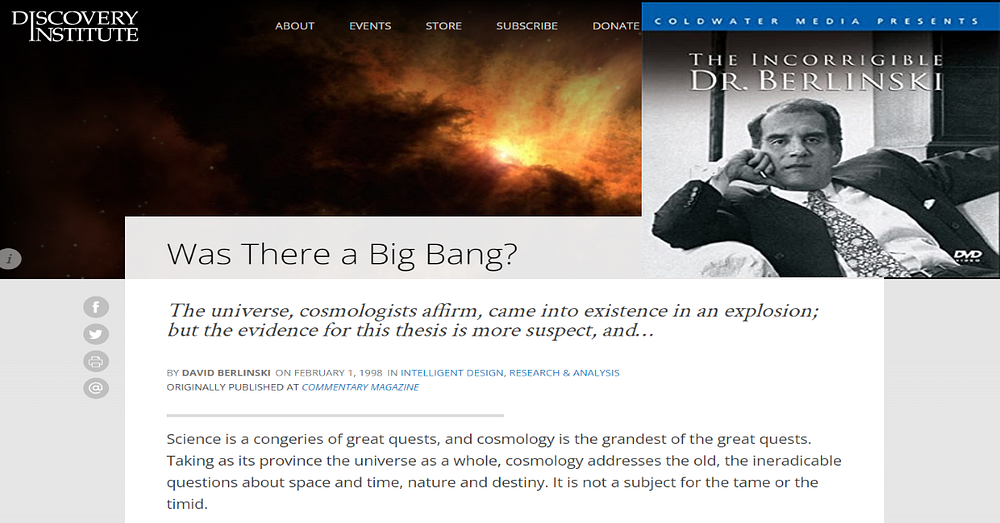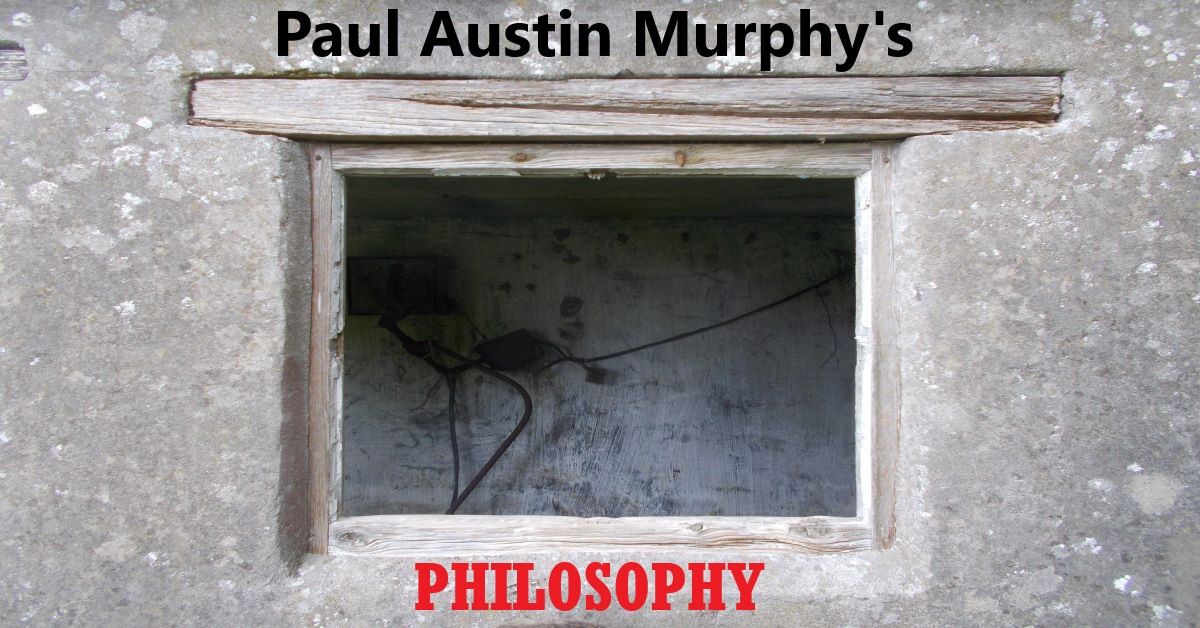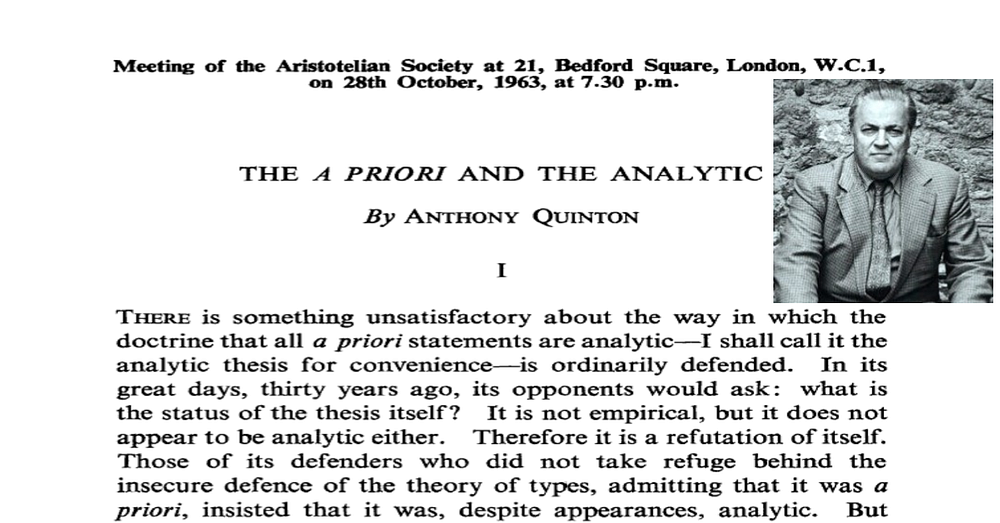The controversial American polemicist David Berlinski states that “contemporary cosmologists feel free to say anything that pops into their heads”. He also compares the Big Bang theory to Norse mythology. This essay discusses his claims.

David Berlinski is a well known and controversial writer and polemicist.
Berlinski rejects — or, perhaps, simply questions — the Big Bang theory, the theory of evolution and the cosmological inflationary theory. He also rejects (or simply questions) the existence of black holes, the multiverse, etc.
Perhaps Berlinski’s broader perspective on science is best expressed in his book The Devil’s Delusion: Atheism and its Scientific Pretensions (2008). More concretely, Berlinski is a signatory to A Scientific Dissent from Darwinism, which was a statement issued by the Discovery Institute in 2001.
One aspect of Berlinski’s critique of science is itself scientific (or perhaps philosophical) and the other part is almost purely sociological and political. (Berlinski writes: “If knowledge is power, then physicists have [] been given an enormous privilege.”)
Some commentators have stressed the fact that Berlinski has only a limited scientific background. The Wikipedia-like website RationalWiki goes further and basically claims that David Berlinski has no scientific credentials whatsoever. (It writes: “Although often referred to as a ‘mathematician’, Berlinski has done no research in mathematics.”) Yet the Discovery Institute (which Berlinski writes for) provides a biography of Berlinski which reads as follows:
“David Berlinski received his Ph.D. in philosophy from Princeton University and was later a postdoctoral fellow in mathematics and molecular biology at Columbia University. He is currently a Senior Fellow at Discovery Institute’s Center for Science and Culture. Dr. Berlinski has authored works on systems analysis, differential topology, theoretical biology, analytic philosophy, and the philosophy of mathematics, as well as three novels. He has also taught philosophy, mathematics and English at such universities as Stanford, Rutgers, the City University of New York and the Universite de Paris. In addition, he has held research fellowships at the International Institute for Applied Systems Analysis (IIASA) in Austria and the Institut des Hautes Etudes Scientifiques (IHES) in France.”
Do these credentials impress RationalWiki? Obviously not. That seems to be mainly because Berlinski hasn’t written any academic papers on physics or science generally. (RationalWiki also states: “It is worth noting that his books on mathematics are popular books.”)
As for theoretical physics and cosmology specifically (i.e., not the Darwinism Berlinski has a serious problem with).
The American biologist Jerry Coyne (who — to be a contrarian myself — has a Darwinian horse in this race) sums Berlinski’s general position up in the following manner:
“Science has no answers to ‘The Big Questions’ like ‘why is there something instead of nothing?’ (the answer that ‘it was an accident’ is fobbed off by Berlinski as ‘failing to meet people’s intellectual needs’, which of course is not an answer but a statement about confirmation bias); ‘where did the Universe come from?’; ‘how did life originate?’; ‘what are we doing here?’, ‘what is our purpose?’, and so on. Apparently Berlinski doesn’t like ‘we don’t know’ as an answer, but as a nonbeliever I’d like to know his answer! He has none; all he does is carp about science’s ignorance.”
Jerry Coyne’s words have just been quoted specifically because they more or less square with some of the positions which will be advanced in the following essay.
As stated, Berlinski seems to be primarily motivated by the (for want of a better term) sociology of science, politics and the defense of religion. This means that it’s hard — at least at first — to see why that would motivate him to be so strident when it comes to so much contemporary theoretical physics and cosmology.
Is this because Berlinski connects literally all contemporary theoretical physics and cosmology to atheism (which he certainly has a big problem with)?
So it’s deeply ironic that many other defenders of religion — or the belief in God — only ever mention physics or quote scientists when such mentions and quotes can be squared with (or connected to) their prior religious or “spiritual” views. Thus such people have written entire books or articles in which they cite scientific data which they believe doesn’t conflict with religious views at all — quite the opposite. Yet, even in these cases, science is hardly mentioned at all outside of their own personal religious or theistic contexts.
All that said, much has also be written about Berlinski’s contrarianism (i.e., not his scepticism) being an end in itself.
[See the critical article ‘Ode to the Contrarian’, which mentions Berlinski. This piece, however, lumps all supposed contrarians together and fails to distinguish those people who are — well — contrarian about a single scientific subject/issue from across-the-board contrarians like Berlinski himself.]
In the following essay, most of the quotes from Berlinski come from his ‘Was There a Big Bang?’. The subheading to that essay reads as follows:
“The universe, cosmologists affirm, came into existence in an explosion; but the evidence for this thesis is more suspect [].”
The essay ends with this paragraph:
“Like Darwin’s theory of evolution, Big Bang cosmology has undergone that curious social process in which a scientific theory is promoted to a secular myth. The two theories serve as points of certainty in an intellectual culture that is otherwise disposed to give the benefit of the doubt to doubt itself. [] Myths are quite typically false, and science is concerned with truth. Human beings, it would seem, may make scientific theories or they may make myths, but with respect to the same aspects of experience, they cannot quite do both.”
Now for a final introductory comment.
I can’t claim to be an expert on David Berlinski and I certainly haven’t read everything — or even much — that he’s written. So I’ve simply tackled his words and arguments as they’re expressed in his aforementioned essay on the Big Bang (as well as a spattering of his words from elsewhere). ‘Was There a Big Bang?’ is long. It’s almost 9,000 words in length — i.e., twice as long as my own response here. (That makes it slightly longer than the average academic paper.) What’s more, virtually every sentence within Berlinski’s essay is expressed in an extremely literary (or poetic) manner. (Berlinski calls his own writing style “rhapsodic and florid”.) And that may explain why some of it — to be honest, though not sarcastic — went over my head.
It also needs to be said here that when it comes to a lot of the scientific issues and theories discussed in this essay, I’m not completely on top of all the technical details. Put simply: I’m not a mathematical physicist…
Then again, I’m pretty sure that the very same thing can be said about David Berlinski himself.
Berlinski on Metaphysical Speculation
In his essay ‘Was There a Big Bang?’, Berlinski is often vague, rhetorical and very literary about the issue of speculation in theoretical physics and cosmology. However, he does actually cite various concrete examples. He also offers some technical detail.
For example, Berlinski writes:
“Unhappy examples are everywhere; absurd schemes to model time on the basis of the complex numbers, as in Stephen Hawking’s A Brief History of Time, bizarre and ugly contraptions for cosmic inflation; universes multiplying beyond the reach of observation; white holes, black holes, worm holes, and naked singularities; theories of every strip and variety, all of them uncorrected by any criticism beyond the trivial.”
Berlinski seems to take the extreme and (to use his word) absurd position that all speculation — and indeed all hypothesising — in theoretical physics (perhaps all physics) and cosmology is beyond the pail. Yet if such a position on speculation were ever (as it were) made law, then that would have destroyed all physics from day one.
Berlinski also seems to be ignorant of the history of science (or simply one aspect thereof) when he uses phrases such as “there is [] no evidence whatsoever in favour of” various contemporary theories in theoretical physics and cosmology. He should — and probably does — know that all sorts of theories which began life as hypotheses — or even straight speculations — were later backed up by observations, tests, experiments, data, etc. All this was true of Maxwell’s kinetic theory, Paul Dirac’s postulation of an “anti-electron”, Murray Gell-Mann’s “quark model”, etc. There are, of course, many other examples. Indeed it can be assumed that physicists themselves could provide a list that’s as long as their collective arm…
Unless, that is, Berlinski rejects all these theories and entities too.
As it is, it’s hard to know what precise technical problems Berlinski has with using “complex numbers”, the “bizarre and ugly contraptions for cosmic inflation”, “worm holes”, “naked singularities”, etc. So perhaps this has nothing to do with Berlinski’s own technical problems with such arcana. Perhaps Berlinski has purely aesthetic, religious, political and/or philosophical problems with these theories and speculations.
Alternatively, perhaps Berlinski’s contrarianism-as-an-end-in-itself is at the heart of the matter.
So the question is whether Berlinski has a problem with what may be called pure speculation. Or to ask a simpler question:
Is Berlinski ruling out all future observational and experimental backup for all speculations in theoretical physics and cosmology a priori?
Take the American theoretical physicist and cosmologist Alan Guth (1947-), whose inflationary theory is targeted by Berlinski (see later section).
The American theoretical physicist Lee Smolin (who’s also targeted by Berlinski) argues that “the theory of inflation predicts that omega should be equal to one.” He continues:
“Therefore the inflationary theory is subject to experimental tests, observational tests. These tests are going to occur in the next ten of fifteen years.”
And, lo and behold, that’s what happened!…
Well, not quite.
It’s true that the basics of inflationary theory (if there are such things) are accepted by most physicists. That’s primarily because many of Guth’s predictions have been confirmed by observation. More specifically, Guth’s theory accounts for the homogeneity of the observable universe. It also accounts for the observed flatness. Indeed, since Guth’s early work, much of his theory has received further confirmation. This is especially the case when it comes to the detailed observations of the cosmic microwave background made by the Planck spacecraft.
However, an important minority of scientists have serious problems with Guth’s inflationary theory. And that, in a strong sense, is both a good and a bad thing (as Popperians would argue) for theoretical physics and cosmology . To Berlinski, on the other hand, all such disagreements (or anomalies) are portrayed as being deeply profound and disturbing. And that’s precisely why he uses such disagreements as weapons against contemporary science.
Berlinski goes on to write:
“What are discovering is that many areas of the universe are apparently protected from our scrutiny, like sensitive files sealed from view by powerful encryption codes.”
Now that passage could be about the multiverse theory, the extra dimensions and branes of string theory and God knows what else. Yet it must be said here that such critical and sceptical words have also been uttered by some well-known and high-ranking physicists themselves (even if their prose styles are not at all like Berlinski’s own).
For example, much has been written by (ironically) Lee Smolin about the purely mathematical and speculative nature of string theory. (The main claim is that string theory suffers from an “absence of falsifiable predictions”; and what predictions it does offer aren’t “unique”.) Smolin even wrote the following words (i.e., in his book The Trouble With Physics: The Rise of String Theory, the Fall of a Science, and What Comes Next) about string theory:
“The feeling was that there could be only one consistent theory that unified all of physics, and since string theory appeared to do that, it had to be right. No more reliance on experiment to check our theories. That was the stuff of Galileo. Mathematics [alone] now sufficed to explore the laws of nature. We had entered the period of postmodern physics.”
Another example is theoretical physicist Brian Greene’s (non-literary and non-rhetorical) take on the idea of a multiverse. He states:
“The danger, if the multiverse idea takes root, is that researchers may too quickly give up the search for such underlying explanations. When faced with seemingly inexplicable observations, researchers may invoke the framework of the multiverse prematurely — proclaiming some phenomenon or other to merely reflect conditions in our own bubble universe and thereby failing to discover the deeper understanding that awaits us.”
And, finally, the British astrophysicist and cosmologist Martin Rees says more or less the same thing Brian Greene in the following:
“If people believed that some features of the universe were not fundamental but just accidents, resulting from the particular way our domain in the meta-universe cooled down, then they’d be less motivated to try to explain them.”
If we return to pure speculations.
Are such speculations (i.e., from theoretical physicists and cosmologists) automatically “metaphysics” simply because there’s no observational and/or experimental evidence for them? Indeed would the metaphysical status of such speculations automatically be a bad thing if, at least in principle, future findings, tests, observations, experiments, etc. would turn them (as it were) non-metaphysical?
So what does Berlinski himself believe?
He believes the following:
“This scrupulousness has been compromised. The result has been the calculated or careless erasure of the line separating disciplined physical inquiry from speculative metaphysics. Contemporary cosmologists feel free to say anything that pops into their heads.”
Some readers may think that a person like Berlinski (i.e., as a strong critic of contemporary science and the social/political — his word — “power” of physicists) would have some time for metaphysics — if not also for “speculative metaphysics”. (It has been said that all metaphysics is speculative.) Who knows. Perhaps Berlinski does have time for metaphysics; just not when it’s carried out by those scientists he has no time for.
In any case, Berlinski singles out Lee Smolin’s cosmological natural selection in which (to use Berlinski’s own words) “the Big Bang happened within a black hole”.
Berlinski on Smolin’s Cosmological Natural Selection
Berlinski writes:
“There is, needless to say, no evidence whatsoever in favour of this preposterous theory. The universes that a bubbling up are unobservable. So, too, are the universes that have bubbled up and those that will bubble up in the future. Smolin’s theories cannot be confirmed by experience. Or by anything else. What law of nature could reveal that the laws of nature are contingent?”
Of course quarks and all the other particles are (to use Berlinski’s own word) “unobservable” too. Strictly speaking, the four forces of physics are unobservable — even if their effects aren’t. So too is the past, the future, other minds, the earth’s core, numbers, etc.
[The line between what’s observable and what’s not is vague and the issue is complicated. See ‘The Image of Observables’ by Valerie Gray Hardcastle.]
Physicists postulated atoms, particles and other fundamentals of physics primarily via theory and mathematics and only then did experiments and (indirect) observations save the day. Indeed pure speculation has often been what got the scientific ball rolling.
However, it’s not being argued here that Smolin’s theory of cosmological natural selection is in exactly the same ballpark — and in every respect — as, say, Murry Gell-Mann’s quark model (i.e., as it was before any experimental confirmation) and other well-known cases.
What’s more, even if a claim or theory is indeed speculative, then does that automatically mean that it must have simply (as Berlinski puts it) popped into the head of the speculator — especially if that speculator is a theoretical physicist or cosmologist?
Ironically, it’s possible that Berlinski has (as it were) borrowed some — or even all — of his (sceptical/contrarian) criticisms of theoretical physics and cosmologists from physicists — as the quotes above show. So perhaps his alternatives (although he rarely — if ever — states them) might be borrowed from physicists too.
Take the English cosmologist, theoretical physicist and mathematician John D. Barrow (who died in 2020).
Barrow himself seemed to be referring to Smolin’s theory — and, perhaps less directly, to the idea of a multiverse — when he wrote the following words:
“There has grown up, even amongst many educated persons a view that everything in Nature, every fabrication of its laws, is determined by the local environment in which it was nurtured — that natural selection and the Darwinian revolution have advanced to the boundaries of every scientific discipline.”
Berlinski on the Big Bang Theory
Despite the lack of details for some wild statements — and the lack of any alternatives — in his essay ‘Was There a Big Bang?’, Berlinski does offer a fair amount of technical detail when he discusses the case against the Big Bang. His main (or indeed only) technical point is that the redshift isn’t conclusive evidence — or evidence at all — for the Big Bang. He cites the work of the American astronomer Halton Arp (1927–2013) to back up his own position. Alternatively put: perhaps Berlinski’s case against the Big Bang theory is entirely due to Arp’s work.
[Arp was a critic of the Big Bang theory who advanced what’s called a non-standard cosmology — see here.]
In any case, Berlinski main weapon against contemporary theoretical physics and cosmology is to stress disagreements among theoretical physicists and cosmologists and then draw hugely negative conclusions from them (as well as failing to realise — or simply note — that most physicists embrace anomalies).
Berlinski also questions the Big Bang metaphor of the switching on of a light and the subsequent creation of time itself. Yet he also rejects the existence of the multiverse, which could provide an answer to his questions. Indeed so too could Lee Smolin’s cosmological natural selection, which he calls “preposterous”.
Yet, as already stated, there is some substance (underneath the literary rhetoric) within Berlinski’s words. Take the following passage:
“[T]he image of the fundamental laws of physics zestfully wrestling with the void to bring the universe into being is one that suggests very little improvement over the account given by the ancient Norse in which the world is revealed to be balanced on the back of a gigantic ox.”
The fact is that some theoretical physicists and commentators have also stated as much — even if Berlinski’s comparison with Norse mythology is cheap and rhetorical. That is, some theoretical physicists themselves have seen the problems here. (Again, Berlinski might have actually borrowed these arguments from such physicists.)
Here’s another passage from Berlinski:
“The image of a light switch comes from Paul Davies, who uses it to express a miracle without quite recognizing that it embodies a contradiction. A universe that has suddenly switched itself on has accomplished something within time; and yet the Big Bang is supposed to have brought space and time into existence.”
Berlinski must know that there are many answers (if not necessarily correct or acceptable answers) to this issue in theoretical physics and cosmology. The problem is that he doesn’t like any of these answers either.
So now take these words from Lee Smolin (again):
“But if time does not end, then there is something there, happening. The question is, What? This is very like the question about what happened ‘before the Big Bang’ in the event that quantum effects allow time to extend indefinitely into the past.”
The problem here is that this passage also includes references to Berlinski’s unobservables. (Is Berlinski a 19th-century positivist or Machian?) So Berlinski wouldn’t like Smolin’s alternative either. This effectively means that Berlinski doesn’t like the idea of time suddenly being switched on… And he doesn’t like any of the alternatives either.
So perhaps Berlinski should just “put up or shut up” instead! (To requote Jerry Coyne: Berlinski “has none” of the answers. “All he does is carp about science’s ignorance.”)
All that said, some physicists can be adopted (or co-opted) to express Berlinski’s problems and worries.
Take the the physicist John Archibald Wheeler and Berlinski’s (now repeated) words
“the image of the fundamental laws of physics zestfully wrestling with the void to bring the universe into being”.
Wheeler had (kinda) already expressed Berlinski’s own position when he provided a good riposte to (for want of a better term) Pythagoreanism in physics.
The fairly-well-known story is that Wheeler used to write many obscure and technical equations on the blackboard and then stand back and say to his students:
“Now I’ll clap my hands and a universe will spring into existence.”
[According to Pythagoreans, however, the equations are the universe.]
Then Stephen Hawking (a physicist Berlinski also criticises) outdid Wheeler with an his even-better-known passage. He wrote:
“Even if there is only one possible unified theory, it is just a set of rules and equations. What is it that breathes fire into the equations and makes a universe for them to describe?”
Yet the science writer Kitty Ferguson offers a (possible) Pythagorean answer (as already hinted at) to Hawking’s question when she says that “it might be that the equations are the fire”. Alternatively, could Hawking himself have been “suggesting that the laws have a life or creative force of their own?”.
Again, is it that the “equations are the fire”?
This hint at Pythagoreanism is expressed by both the friends and the foes of contemporary theoretical physics and cosmology.
For example, this is how a non-scientist friend of science puts it:
“While some cosmologists are speculating that the laws of physics might explain the origin of the universe, the origin of the laws themselves is a problem so unfathomable that it is rarely discussed [] Is there a way in which the universe may have organized itself?”
So Berlinski could now legitimately ask theoretical physicists and cosmologists this question:
What, exactly, “breathes fire into the equation to make a world”?
Alternatively, we could ask Berlinski himself that very same question! (Berlinski, please put up or shut up!)
Berlinski on Alan Guth’s Inflationary Theory
As partially stated in the introduction, I don’t know all the technical details on this specific issue…
But does David Berlinski?
It may be tempting to assume that Berlinski is missing something when it comes to the Big Bang and the parallel something-from-nothing scenario (which is not from Norse mythology). Alternatively, perhaps Berlinski has simply misinterpreted (or simplified) this scenario in the haze of his flamboyant prose.
All that said, surely Berlinski’s statements are broadly legitimate. Or to put that in a weaker way: Surely non-experts (as well as experts themselves) are right to ask the questions which Berlinski asks.
So it may help readers when Berlinski actually offers some technical details here. Berlinski writes:
“Having entered a dark logical defile, physicists often find it difficult to withdraw. Thus, Alan Guth writes in pleased astonishment that the universe really did arise from ‘essentially… nothing at all’: as it happens, a false vacuum patch ‘10⁻²⁶ centimetres in diameter’ and ‘10⁻³² solar masses’.”
He concludes:
“It would appear, then, that ‘essentially nothing’ has both spatial extension and mass. While these facts may strike Guth as inconspicuous, others may suspect that nothingness, like death, is not a matter that admits of degree.”
It does — again — seem that Berlinski has a point…
But that’s only if he’s characterised Alan Guth’s position correctly. (It could of course be the case that Berlinski’s quotes from Guth are artfully out of context.)
Yet, on the surface at least, it does seem that Berlinski has (more or less) expressed Guth’s position correctly.
So here’s Guth himself on the “false vacuum”:
“[A] ‘false vacuum,’ which is the driving force behind inflation. We discovered that a large enough region of false vacuum would create a new universe, which, as I described earlier, would rapidly disconnect from ours and become totally isolated.”
More relevantly:
“Since the mass density of the false vacuum is approximately 10⁶⁰ times larger than the density of an atomic nucleus, it would certainly not be easy.”
Guth then admits to a degree of speculation when he concludes:
“Nonetheless, one can speak about the physics of universe creation as a matter of principle, and I find it a very interesting question.”
It’s worth noting here that Guth’s position is now almost standard among many theoretical physicists and cosmologists. For example, take the words of Marcelo Gleiser (1959-), a Brazilian physicist who states the following words:
“We plow ahead, proposing tentative models that join general relativity and quantum mechanics where the universe pops out of nothing, no energy required: All is due to a random quantum fluctuation.”
It may be wondered if Berlinski is conflating a vacuum (or a false vacuum) with nothingness. After all, in the last quote above Guth doesn’t even use the word “nothing”. (Gleiser does!) In any case, it’s crystal clear that the two notions of a vacuum and a false vacuum (in physics) aren’t even meant to be cases of literal nothingness — at least not the nothingness which has often been discussed by philosophers, theologians and others.
Yet, despite that last sentence, let’s still ask this obvious question:
How can nothing have “both spatial extension and mass”?
It may be relevant here that, even according to Berlinski’s own first quote, Guth does prefix his word “nothing” with the word “essentially”. It can now be argued that the words “essentially nothing” actually mean not quite nothing. So perhaps this is an odd and uncareful use of the word “essentially”. And no doubt Guth, as a physicist, would have a problem with such pedantry here…
[The word “pedantry” is used because physicists often do have a problem with philosophers and other people nit-picking the words they use. See my ‘Why Richard Feynman (the Superstar Physicist) Hated Philosophy and Philosophers’.]
But that’s too easy.
It’s too easy because it’s surely acceptable to ask what Guth means by “essentially nothing”. After all, if there is a difference — even a big difference — between nothing and essentially nothing, then that will have a profound impact on the nature of the Big Bang. In other words, the (possible) pedantry above is simply a means of clarifying the actual physics. Many physicists, of course, will argue that only better mathematics and clearer physics can do any of the clarifying which needs to be done…
Finally, perhaps David Berlinski believes that Alan Guth (qua physicist) is playing God. That is, in the best-selling book The Inflationary Universe (published one year before Berlinski’s own ‘Was There a Big Bang?’), Guth speculated as to whether or not it would be possible to create a new universe in his own basement laboratory!












